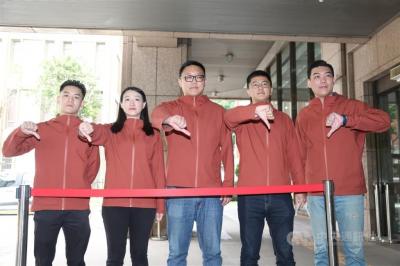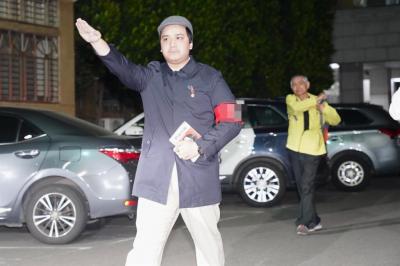The explanations provided by Chunghwa Telecom (CHT) for its decision not to renew the contract of Falun Gong-sponsored New Tang Dynasty Television (NTDTV) contradict information uncovered by the Taipei Times and raise questions about possible pressure from the Chinese or Taiwanese authorities.
Since 1998, CHT has relied on the ST-1 satellite to transmit TV signals to Taiwanese subscribers. With the satellite scheduled to cease operations in August, on Sept. 18, 2008, Chunghwa Telecom Singapore, a fully owned subsidiary of CHT, formed a joint venture with Singapore Telecommunications Ltd (SingTel) to build a new satellite, the ST-2. Information released by CHT showed that its subsidiary would take about a 38 percent stake in the joint venture, with SingTel taking the remaining 62 percent. CHT and SingTel also jointly operate ST-1.
In a press release dated April 5, SingTel announced that the assembly, integration and testing of ST-2 had been completed and that the satellite was being shipped to its launching site, where it is to be launched in the middle of this month.
Responding to criticism over the decision not to renew NTDTV’s contract, meaning its broadcasts will cease in August, CHT said the ST-2 had fewer transponders and therefore had lower bandwidth to ensure a quality service.
Industry sources said ST-1 carries 16 high-power Ku-band transponders and 14 medium-power C-band transponders.
However, CHT’s explanation contradicts what its partner said on April 5.
Bill Chang, executive vice president of the business group at SingTel, said at the time: “With 20 percent more transponder capacity and a wider coverage footprint than ST-1, ST-2 will help increase our capacity to meet growing customer demand for fixed and mobile satellite services in the broadcast, maritime and oil and gas industries.”
A Singaporean source confirmed to the Taipei Times yesterday that while ST-2 has more transponders, CHT’s share in the satellite has shrunk, meaning it may have been allocated less bandwidth than on ST-1.
Although this could explain why CHT will be unable to assign as many stations as it did before, it does not explain the decision to specifically select NTDTV to be dropped.
One possible explanation could be the stronger signal offered by ST-2. Both CHT and SingTel have said ST-2 will have higher transmitting power than ST-1. The wide-ranging footprint of C-band and Ku-band coverage will cover the Middle East, Central Asia, the Indian subcontinent and Southeast Asia.
“ST-2 is almost twice as powerful as our first satellite, which means our customers’ antennas don’t have to work as hard to pick up the signals,” Chang said.
Those comments may have caught Beijing’s attention.
Beijing considers Falun Gong a cult and has made it an illegal entity in China. It has successfully blocked — and sometimes intimidated other countries into doing so — broadcasts from NTDTV.
Although satellites like ST-1 and ST-2 do not service the Chinese market, a technique known as “signal hacking” reportedly allows direct access to channels and programs on any satellite that services the Asia-Pacific region.
In October 2009, Taiwanese lawmakers called for an investigation into ST-1 signal interruptions that began on Sept. 17 and peaked on Oct. 1, when the People’s Republic of China was celebrating its 60th anniversary. On Double Ten Day, NTDTV’s broadcasts were effectively taken off the air for the entire day.
ST-1’s low-band frequency covers all of Taiwan and 80 percent of China. The higher transmitting power of ST-2 could ostensibly make it more difficult for China to jam its signals, as it did in the lead-up to the 60th anniversary celebrations.
Although the Taipei Times could not confirm this information, Beijing may have pressured CHT or SingTel not to renew NTDTV’s contract.
Earlier this week, CHT denied there was any political reason behind its decision.
The incident occurs at a time when CHT is seeking to expand its operations in China. On March 28, the company announced the establishment of a wholly owned subsidiary, Chunghwa Telecom (China), in Shanghai, to promote its information and communications technology. This includes CHT’s intelligent energy-saving solutions iEN, which will be initially promoted in Fujian Province through cooperation with a provincial branch of state-owned China Mobile. CHT has also made a number of investments and joint ventures in China and is in negotiations with state-owned China Telecom Corp to enter the Chinese market.
ST-2 departed Kamakura, Japan, at the end of March and arrived in French Guiana on an Antonov An-124 cargo aircraft on April 5, Mitsubishi Electric Corp of Japan, the manufacturer of the satellite, said in a press release on April 6.
Industry watchers said ST-2 is to be launched at the Guiana Space Center in Kourou on an Ariane 5 orbital launch vehicle.
The satellite, which has an expected 15-year lifespan, will be in orbit at 88 degrees east longitude, Mitsubishi Electric said.
Contacted for further comment, Mitsubishi Electric said it could not provide specific details about ST-2, stating a non-disclosure agreement with its customer.
According to the CHT Web site, the Ministry of Transportation and Communications owns 35.41 percent of its shares.

Taiwan is stepping up plans to create self-sufficient supply chains for combat drones and increase foreign orders from the US to counter China’s numerical superiority, a defense official said on Saturday. Commenting on condition of anonymity, the official said the nation’s armed forces are in agreement with US Admiral Samuel Paparo’s assessment that Taiwan’s military must be prepared to turn the nation’s waters into a “hellscape” for the Chinese People’s Liberation Army (PLA). Paparo, the commander of the US Indo-Pacific Command, reiterated the concept during a Congressional hearing in Washington on Wednesday. He first coined the term in a security conference last

Prosecutors today declined to say who was questioned regarding alleged forgery on petitions to recall Democratic Progressive Party (DPP) legislators, after Chinese-language media earlier reported that members of the Chinese Nationalist Party (KMT) Youth League were brought in for questioning. The Ministry of Justice Investigation Bureau confirmed that two people had been questioned, but did not disclose any further information about the ongoing investigation. KMT Youth League members Lee Hsiao-liang (李孝亮) and Liu Szu-yin (劉思吟) — who are leading the effort to recall DPP caucus chief executive Rosalia Wu (吳思瑤) and Legislator Wu Pei-yi (吳沛憶) — both posted on Facebook saying: “I

The Ministry of Economic Affairs has fined Taobao NT$1.2 million (US$36,912) for advertisements that exceed its approved business scope, requiring the Chinese e-commerce platform to make corrections in the first half of this year or its license may be revoked. Lawmakers have called for stricter enforcement of Chinese e-commerce platforms and measures to prevent China from laundering its goods through Taiwan in response to US President Donald Trump’s heavy tariffs on China. The Legislative Yuan’s Finance Committee met today to discuss policies to prevent China from dumping goods in Taiwan, inviting government agencies to report. Democratic Progressive Party Legislator Kuo Kuo-wen (郭國文) said

Sung Chien-liang (宋建樑), who led efforts to recall Democratic Progressive Party (DPP) Legislator Lee Kun-cheng (李坤城), was released on bail of NT$80,000 today amid outcry over his decision to wear a Nazi armband to questioning the night before. Sung arrived at the New Taipei District Prosecutors’ Office for questioning in a recall petition forgery case last night wearing a red armband bearing a swastika, carrying a copy of Adolf Hitler’s Mein Kampf and giving a Nazi salute. Sung left the building at 1:15am without the armband and covering the book with his coat. Lee said today that this is a serious